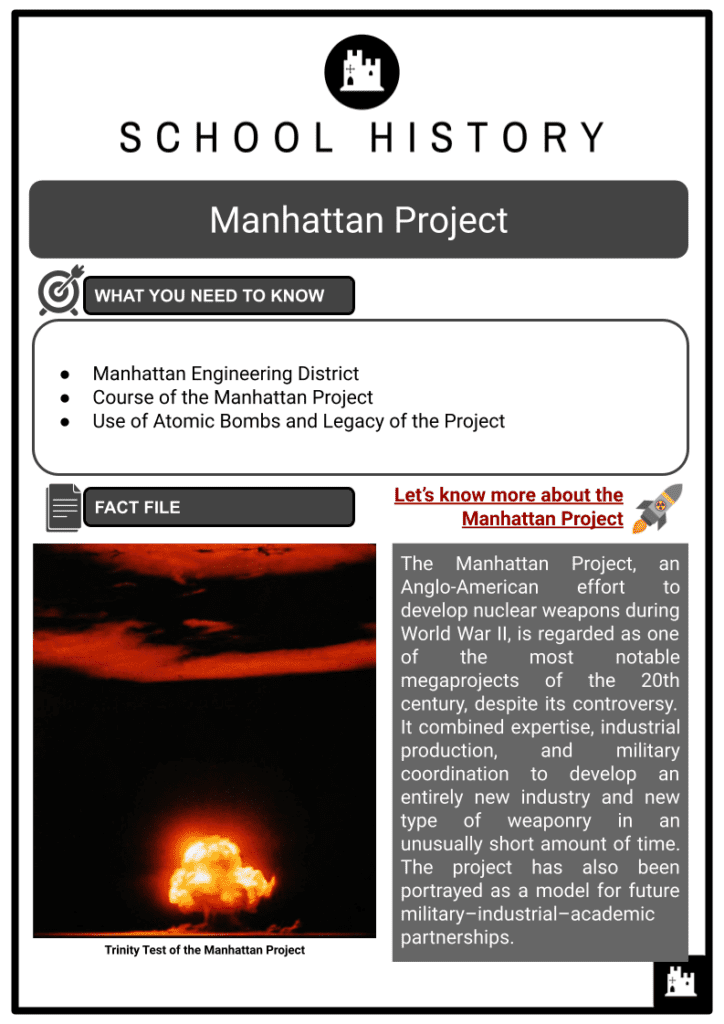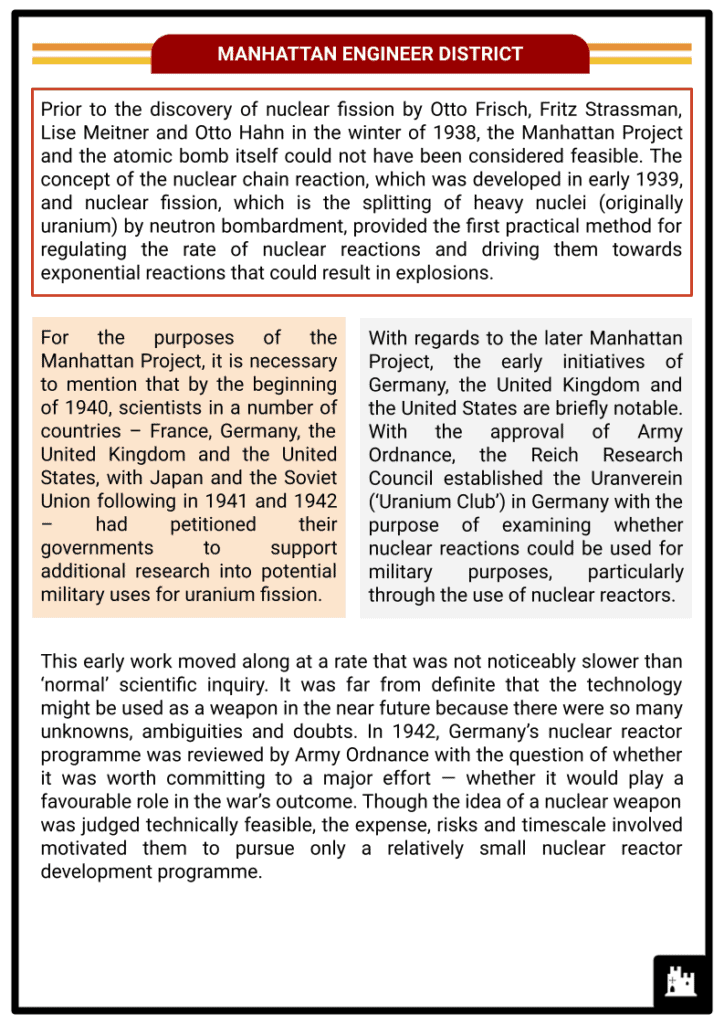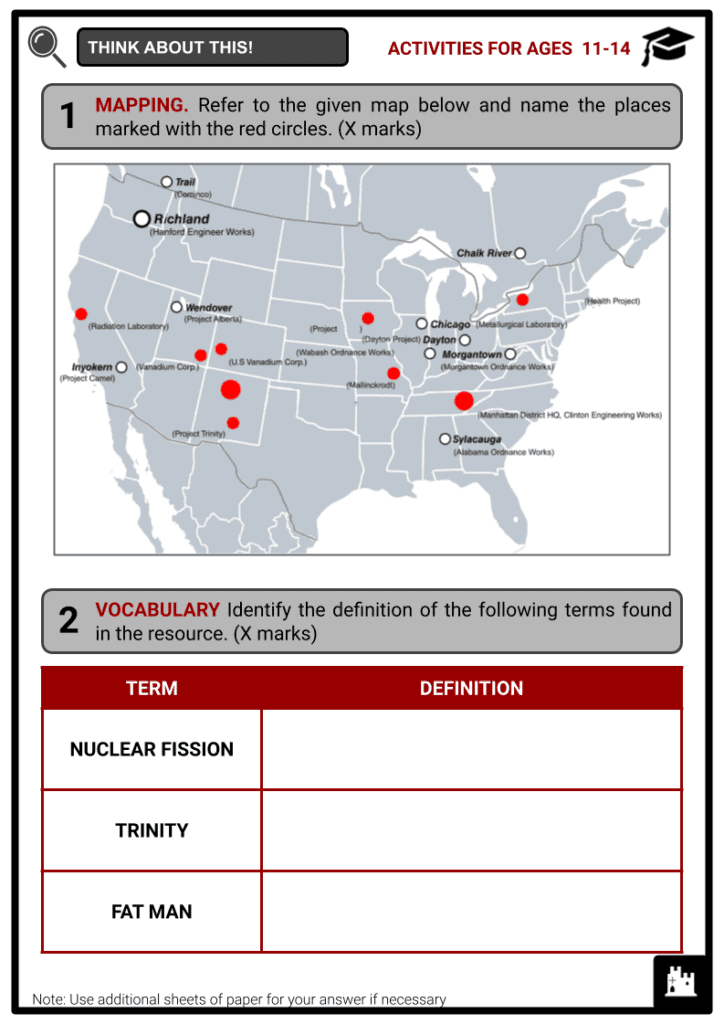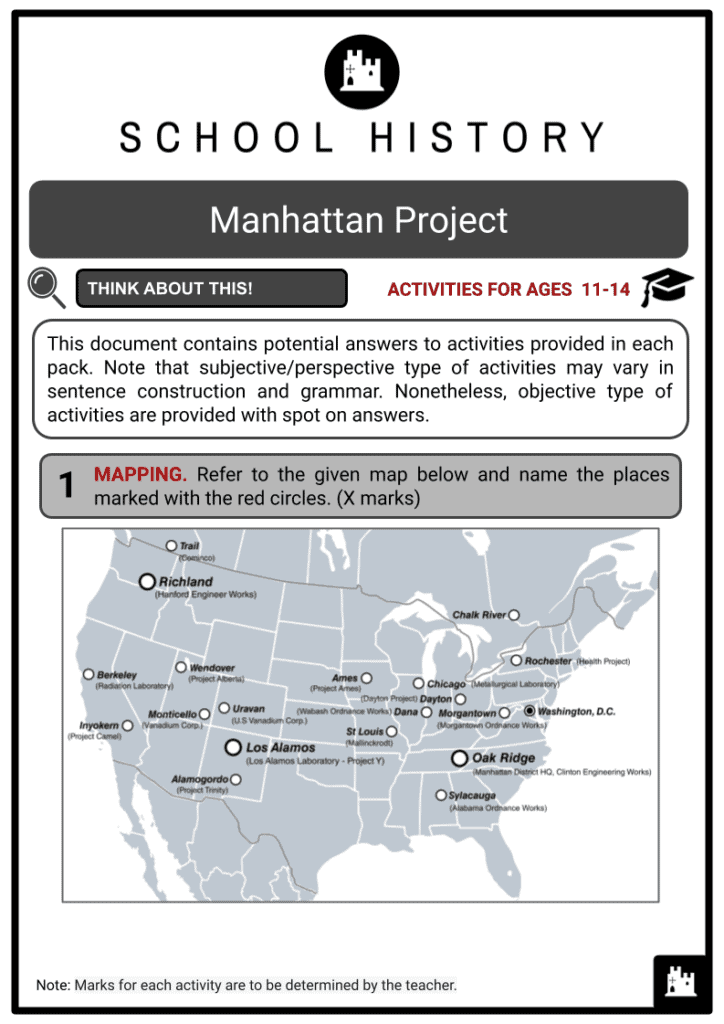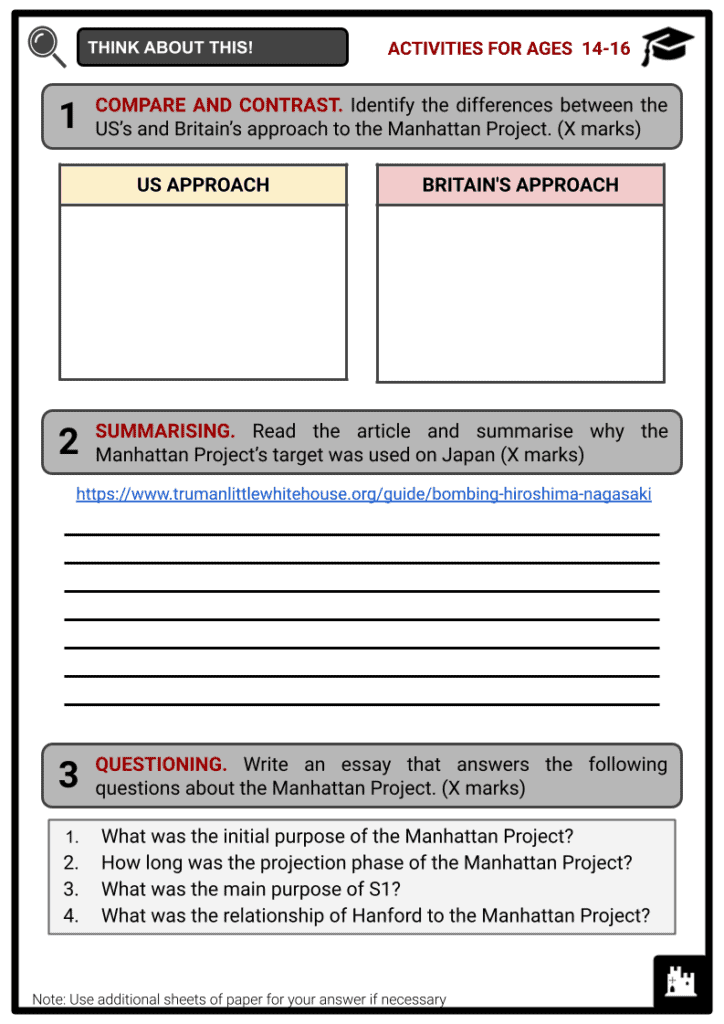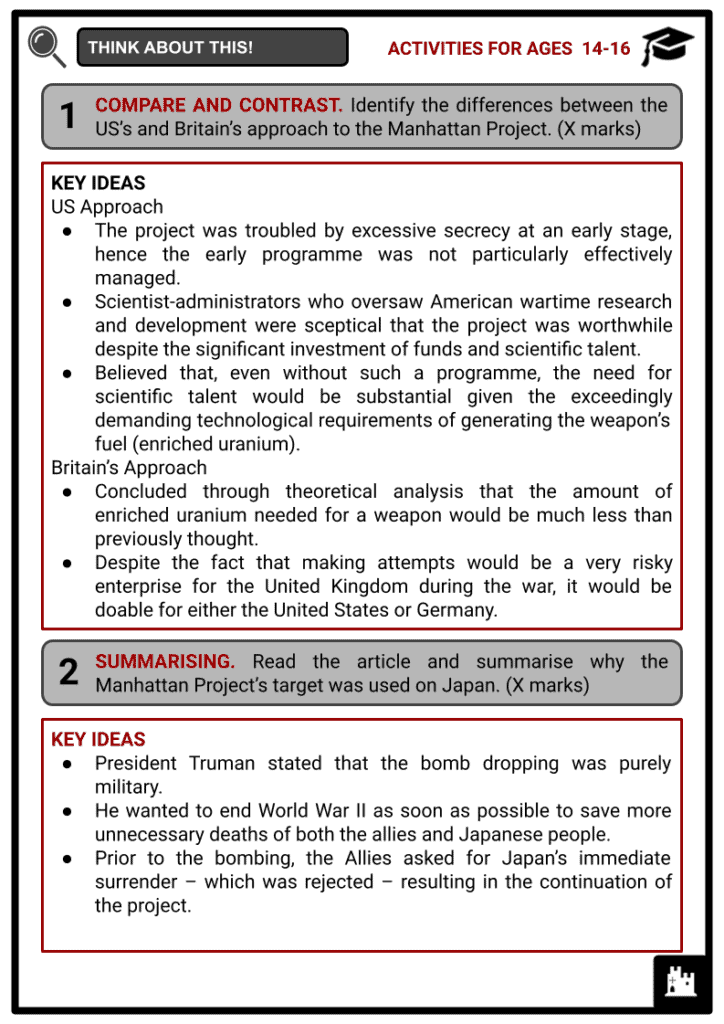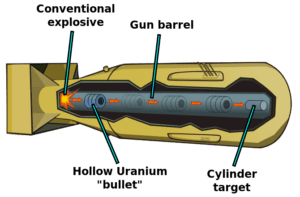Manhattan Project Worksheets
Do you want to save dozens of hours in time? Get your evenings and weekends back? Be able to teach about the Manhattan Project to your students?
Our worksheet bundle includes a fact file and printable worksheets and student activities. Perfect for both the classroom and homeschooling!
Summary
- Manhattan Engineering District
- Course of the Manhattan Project
- Use of Atomic Bombs and Legacy of the Project
Key Facts And Information
Let’s find out more about the Manhattan Project!
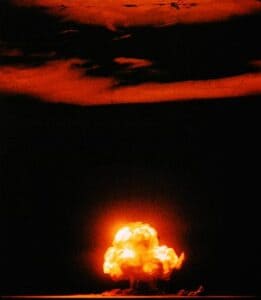
The Manhattan Project, an Anglo-American effort to develop nuclear weapons during World War II, is regarded as one of the most notable megaprojects of the 20th century, despite its controversy. It combined expertise, industrial production, and military coordination to develop an entirely new industry and new type of weaponry in an unusually short amount of time. The project has also been portrayed as a model for future military–industrial–academic partnerships.
MANHATTAN ENGINEER DISTRICT
- Prior to the discovery of nuclear fission by Otto Frisch, Fritz Strassman, Lise Meitner and Otto Hahn in the winter of 1938, the Manhattan Project and the atomic bomb itself could not have been considered feasible. The concept of the nuclear chain reaction, which was developed in early 1939, and nuclear fission, which is the splitting of heavy nuclei (originally uranium) by neutron bombardment, provided the first practical method for regulating the rate of nuclear reactions and driving them towards exponential reactions that could result in explosions.
- For the purposes of the Manhattan Project, it is necessary to mention that by the beginning of 1940, scientists in a number of countries – France, Germany, the United Kingdom and the United States, with Japan and the Soviet Union following in 1941 and 1942 – had petitioned their governments to support additional research into potential military uses for uranium fission.
- With regards to the later Manhattan Project, the early initiatives of Germany, the United Kingdom and the United States are briefly notable. With the approval of Army Ordnance, the Reich Research Council established the Uranverein (‘Uranium Club’) in Germany with the purpose of examining whether nuclear reactions could be used for military purposes, particularly through the use of nuclear reactors.
- This early work moved along at a rate that was not noticeably slower than ‘normal’ scientific inquiry. It was far from definite that the technology might be used as a weapon in the near future because there were so many unknowns, ambiguities and doubts. In 1942, Germany’s nuclear reactor programme was reviewed by Army Ordnance with the question of whether it was worth committing to a major effort — whether it would play a favourable role in the war’s outcome. Though the idea of a nuclear weapon was judged technically feasible, the expense, risks and timescale involved motivated them to pursue only a relatively small nuclear reactor development programme.
- The effort of the United States, left to its own devices, could have very well gone the same way. Vannevar Bush and James B Conant, two of the leading American scientist-administrators who oversaw the direction of American wartime research and development, were sceptical that the project was feasible given the significant investment of funds and scientific manpower.
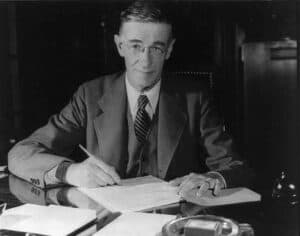
Vannevar Bush - The British programme for nuclear weapons came to very different conclusions from those of two refugee scientists who feared the prospect of Nazis armed with nuclear weapons. Otto Frisch and Rudolf Peierls concluded through theoretical calculation that the enriched-uranium fuel requirements for a bomb would be considerably smaller than had been believed. These conclusions were codified by the MAUD Committee, meant both to warn them of the German possibility and encourage them to take action.
- The S-1 work began in the autumn of 1941, under the auspices of the Office for Scientific Research and Development.
- The aim of the S-1 effort was to create proof-of-concept facilities that would show how uranium could be enriched and a new element, plutonium, could be created from nuclear reactors.
- By the summer of 1942, Vannevar Bush was confident enough in the enterprise to recommend an all-out ‘crash’ effort to develop an atomic bomb. The majority of the organisation was taken over by the Army Corps of Engineers.
- The Manhattan Engineer District was given as a name for the new organisation since the early work had offices in New York City, close to the corporate offices of significant industrial contractors and the scientific research being done at Columbia University.
- In many ways, the invention of nuclear weapons during World War II was an unexpected and implausible development. Despite the opinion of American scientists that it would be very difficult to produce nuclear weapons, important figures were persuaded by the United Kingdom’s lobbying that it was a risk worth taking. The subject received very little attention due to the unique way that American scientific planning for war was organised.
COURSE OF THE MANHATTAN PROJECT
- Only one isotope of uranium was known to fission by neutrons of all strengths as early as 1939. The fissile isotope uranium-235 makes up less than 1% of the uranium that is currently mined; uranium-238 makes up the remaining 99%. Other elements had undergone isotopic separation (for example, the separation of the hydrogen isotope deuterium from the bulk of natural water).
- At various research facilities in the United States, a number of methodologies were put forth and investigated on a modest scale. By the end of the first year of the Manhattan Project (1942), the following contenders were the top choices:
- Electromagnetic separation: Strong magnetic fields were employed to produce looping streams of uranium ions that would somewhat concentrate the lighter isotope at the fringes. The majority of the research for this project was done at Ernest Lawrence’s Radiation Laboratory, which was where he developed the idea of the cyclotron at the University of California.
- Gaseous diffusion: Involved forcing a gaseous form of uranium through a porous barrier with incredibly small passages. Although the effect would need to be amplified through numerous steps before it produced a noticeable separation, the gas molecules carrying the lighter isotope would cross the barrier slightly more quickly than the gas molecules carrying the heavier isotope. This work was initially developed primarily at Columbia University, under the direction of Harold Urey and others.
- Thermal Diffusion: The lighter uranium isotope concentrated at one end, which involved applying severe heat and cold to opposite sides of a long column of uranium gas. Philip Abelson conducted the initial research on this at the Naval Research Laboratory.
- Centrifugal enrichment, which would similarly need a lot of ‘stages’ to be effective, involved rapidly spinning uranium gas to allow for a modest concentration of the lighter element at the centre of the swirling mixture. Jesse W Beams, a physicist, worked on this at the Standard Oil Development Company in New Jersey and the University of Virginia.
- The Manhattan Project’s most significant element, which was actively pursued, was probably the electromagnetic and gaseous diffusion methods. Fifty-two per cent of the total project cost was allocated to the building and running of the two enormous facilities needed for these techniques. Initially intended as a rival process, thermal diffusion ended up being ‘chained’ with the other two in order to achieve the appropriate amount of enrichment.
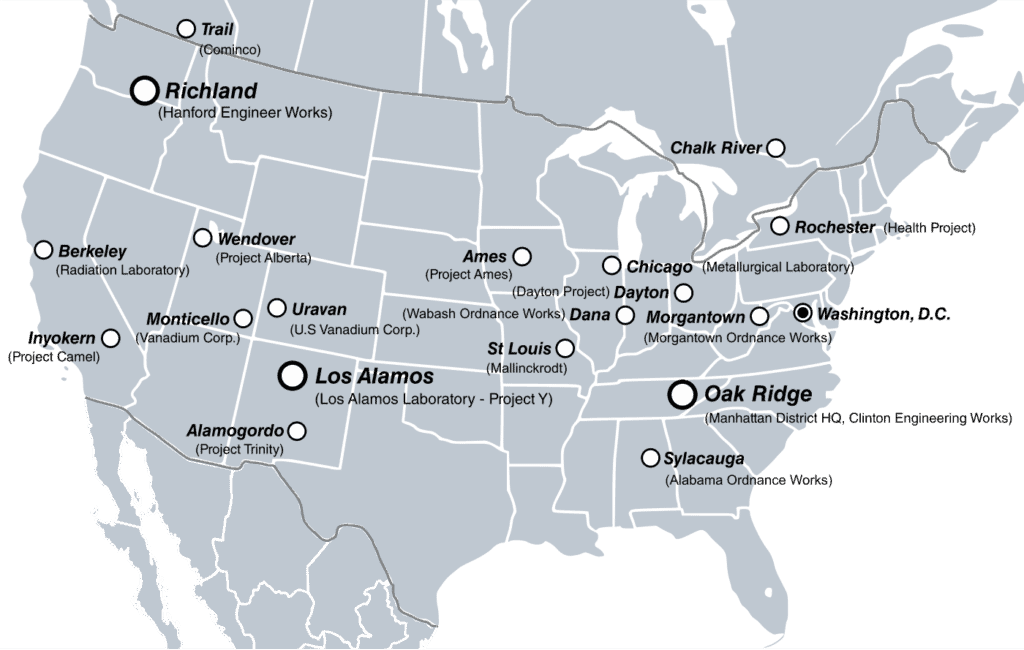
Some of the sites of the Manhattan Project - At its height, the Oak Ridge site (Site X) employed nearly 45,000 people for construction, and a comparable number were paid to manage the site’s ongoing operations. The complex, which was known as a ‘secret city’, held heavily discrete information so that almost none of its thousands of employees had any actual understanding of what they were producing. The facility, which was completely segregated by law and was located in the Jim Crow South, had very different living conditions for African Americans and whites.
- Nuclear reactors had been considered as potential energy sources. However, this would be more challenging than initially thought due to engineering challenges.
- With the use of a ‘moderator’, a controlled nuclear reaction can be created using natural or slightly enriched uranium. This makes it possible for a chain reaction to start even in unenriched material under the correct circumstances.
- Compared to a bomb, the reaction is substantially slower and easier to manage. When plutonium was originally discovered in February 1941, its highly advantageous nuclear characteristics were estimated and confirmed (it is even more reactive than uranium-235, and therefore even less of it is needed for a chain reaction).
- Natural or slightly enriched uranium can be used to create a controlled nuclear reaction. Comparatively speaking, the reaction is far slower and more manageable than the kind that takes place inside a bomb. Purified graphite was used as the moderator in the first reactor, Chicago Pile-1, together with 47 tonnes of naturally occurring (unenhanced) uranium in the form of metal ingots. Nearby, a massive chemical complex called a ‘canyon’ was built, where the irradiated fuel from the reactors was chemically stripped of its plutonium, mostly through automation and remote control.
- Hanford became known as the most radioactively contaminated site in the US and has been the subject of costly clean-up and remediation operations ever since the Cold War ended. About 21% of the Manhattan Project’s overall cost was allocated to the Hanford project. Hanford fuel was and continues to be a crucial bottleneck in the development of nuclear weapons, without which there could be no atomic bomb.
- Of all American wartime endeavours, the Manhattan Project was the biggest and most classified. Brigadier General Leslie R Groves, a West-Point trained engineer who had previously played a key role in the construction of the Pentagon building, served as the leader of the Manhattan Project’s overall operation and was likely the most crucial factor as to whether it would succeed or fail.
- It was initially intended to be a research facility, but it quickly expanded into a massive organisation that undertook numerous research initiatives in order to create the bomb. The Los Alamos site (Site Y) employed around 2,500 employees, with roughly equal numbers of physicists, chemists and engineers.
- The Manhattan Project brought together the largest team of scientists to work on a single project in history. As a result of an Anglo-American alliance negotiated by Winston Churchill and Theodore Roosevelt, a significant British delegation of scientists was also present. Los Alamos expanded as the amount and complexity of the activity increased. The original concept for an atomic bomb was rather straightforward: a cannon barrel would be used to rapidly bring together two pieces of fissile material to form a ‘critical mass’. Although this ‘gun-type’ design required a lot of engineering considerations, it was thought to be rather simple in comparison to other challenges.
- The background neutron rate of reprocessed plutonium rose due to the presence of a contaminating isotope (plutonium-240), reaching levels that would pre-detonate the bomb if two pieces of material were to be shot simultaneously. Only a significantly more rapid approach could be employed to reach a critical mass. The concept of ‘implosion’, a promising but ambitious approach, called for the development of specialised ‘lenses’ of high explosives, arranged as a sphere around a subcritical ball of plutonium, which upon simultaneous detonation would symmetrically squeeze the fuel to over twice its original density.
- The Manhattan Project itself encompassed several hundred distinct locations, all of which varied greatly in terms of their size, location and nature.
- The construction of the facilities that produced this fuel necessitated the procurement of raw materials, machinery and logistics from a large number of locations.
- The location for the manufacturing of polonium, which would be used as a neutron source in the bombs, was created out of a disused playhouse in Dayton, Ohio.
- There was a plan to conduct a full-scale test of the implosion concept in a remote location at the White Sands Proving Ground, which is located 60 miles from Alamogordo, New Mexico.
- The experiment, called ‘Trinity’ by Oppenheimer, was even more successful than anticipated on 16 July 1945, detonating with the force of 20,000 tonnes of TNT.
USE OF ATOMIC BOMBS AND LEGACY
- The Manhattan Project’s core dilemmas – whether and how to use the bombs – have received the smallest amount of discussion in the above. In fact, as the idea of the atomic bomb progressed from the probable to the real in late 1944 and early 1945, a significant amount of governmental and military planning started to take place. It is notable that this project, which was nominally started to counter the threat posed by a German atomic bomb, subtly changed into one that was focused on the first use of such a weapon against Japan. By the time the Manhattan Project leaders started to seriously consider the use of the weapon in late 1944, Germany was no longer a potential target and posed no nuclear danger.
- Two committees in particular were crucial. The first was the Interim Committee, which Secretary of War Henry Stimson established in late 1944 at Bush and Conant’s request.
- The committees’ purview included everything from the introduction of suggestions for the global regulation of nuclear technology to the discussion of the use of bombs in war (because that would probably affect what followed later).
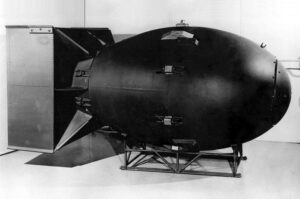
Fat Man - The post-war priorities for new nuclear research, as well as the question of whether the United States would be better served by first demonstrating their new weapon in a non-violent way to Japan rather than by using it militarily, were all subjects that were discussed by a Scientific Panel made up of Oppenheimer, Compton, Fermi and Lawrence.
- The only practical application of the first committee could be against a city, a large urban target.
- Military and scientific professionals made up the second committee, the Target Committee, which convened three times in the spring of 1945 to formulate the final recommendations about the precise usage of the weapons.
- They suggested that the cities of Kyoto, Yokohama, Hiroshima and Kokura be taken into account as potential targets. It took until the end of the summer for the Hiroshima, Kokura, Niigata and Nagasaki target list to be decided.
- Bush, Conant and Oppenheimer stand out in particular for their interest in the post-war environment. They predicted a future in which there would be numerous covert nuclear arms races. Such efforts notably persuaded Stimson, who saw the bomb as more than just a new weapon but also as ‘a new relationship of man to the universe’.
- Oppenheimer attempted to prevent debates on long-term strategy or even the use of bombs at Los Alamos. He stated that such decisions should be made by political authorities rather than by the participants in the scientific community. One of these committees wrote a letter in opposition to dropping the atomic bomb on a city for the first time. Leo Szilard made vain attempts to bring up important policy issues but was forcefully blocked by the military chain of command.
- According to the project’s standards, the mission was a success because the city was completely destroyed and almost half of its inhabitants – roughly 90% of them civilians – were murdered. The second bombing mission, using the implosion weapon code named ‘Fat Man’, was more difficult: the bombing run was marked by several mistakes and disasters. Groves informed his superiors on 10 August 1945 that a third bomb would be ready for use by 17 August.
- The Manhattan Project continues to serve as one of the prototypical instances of a large-scale, resource-intensive partnership that generated groundbreaking outcomes in an incredibly short period of time. It still holds the record for the shortest production phase of any country’s nuclear weapons programme at just 2.5 years. But using the Manhattan Project as a metaphor for heavy resource investment ignores a number of crucial aspects, including its undemocratic nature and its widespread use of militaristic secrecy.
Image Sources
- https://upload.wikimedia.org/wikipedia/commons/thumb/8/8d/Trinity_shot_color.jpg/440px-Trinity_shot_color.jpg
- https://upload.wikimedia.org/wikipedia/commons/e/ea/Vannevar_Bush_portrait.jpg
- https://upload.wikimedia.org/wikipedia/commons/thumb/5/5b/Manhattan_Project_US_Canada_Map_2.svg/1400px-Manhattan_Project_US_Canada_Map_2.svg.png
- https://commons.wikimedia.org/wiki/File:Gun-type_fission_weapon_en-labels.svg
- https://en.wikipedia.org/wiki/Fat_Man#/media/File:Fat_man.jpg

